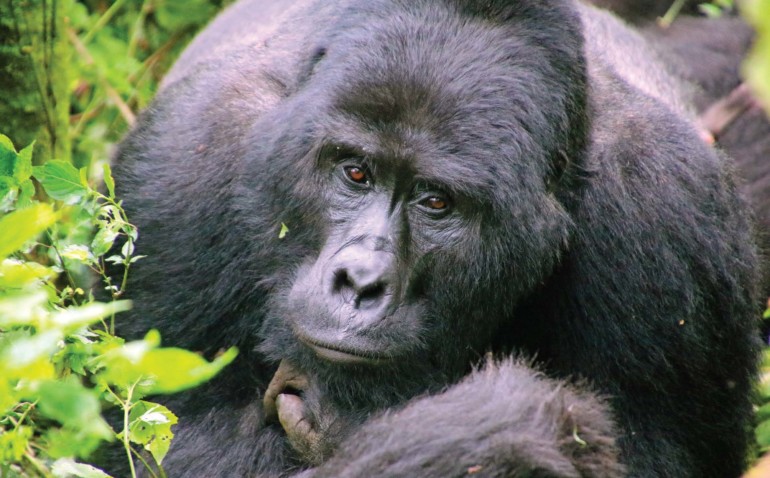WITH HIS WIGGLY saucer-eyed 4-month old son perched atop his mondo furry chest, the sleepy silverback gorilla looks like a storybook gentle giant. Although big Daddy also has a scary rep for violently breaking tree branches while charging at intruders — that’s why he was named Rushenya in the local language. When I first spot him, Rushenya rests on his back, comically grasping his raised feet with mannish fleshy fingers that soon steady his wobbly-legged Elvis coiffed son. Eight other family members are piled around, some grooming each other. Our tracker utters throat-clearing gorilla-speak humm-mmmms, which roughly means “Hello, we come in peace.” Rushenya briefly lifts his bulging forehead to study us. Thankfully he’s Zen. Awhile later, one of his harem who is snuggling a month-old infant to her breast suddenly lets out what sounds like raspy pig grunts.
“Don’t move. She is looking at us suspiciously. She is saying, ‘Keep your distance,’ ” cautions my ranger-guide, Obed Tukwasibwe.
Gorillas are in our midst, about 25 feet away. In Uganda’s remote, dense and storied Bwindi Impenetrable Forest, with my adrenaline surging, I’m helping “train” a 23-member troop of rare semi-habituated mountain gorillas to get accustomed to humans. It’s a process famously associated with the late San Francisco–born primatologist Dian Fossey, a onetime College of Marin and UC Davis attendee who became the world’s most renowned gorilla scientist.
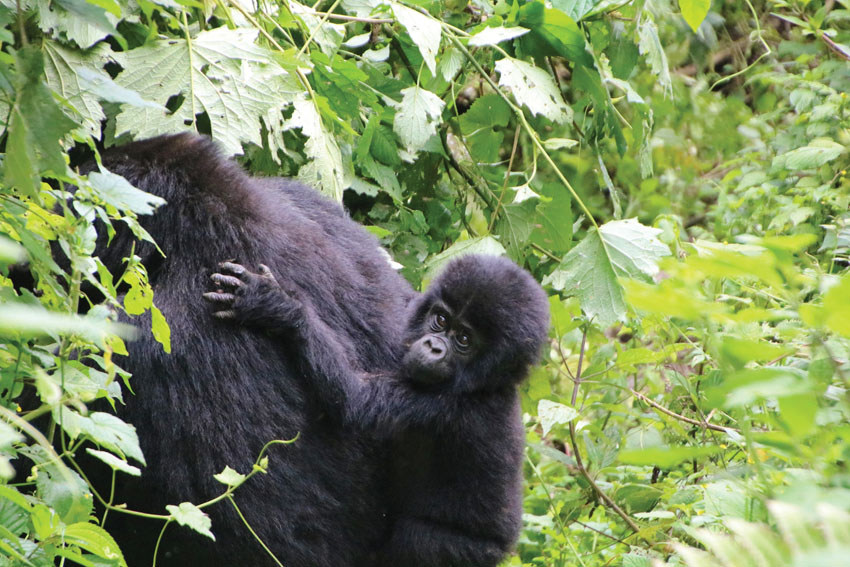
A shy mother from the Bikingi family darts into the bushes.
Surprisingly, I’m the only tourist signed up for this day’s emotionally powerful, fascinatingly insightful and way edgy Gorilla Habituation Experience offered by the Uganda Wildlife Authority. The eventual goal is for these endangered hairy herbivores to view people as “neutral” so conservationists can monitor them and travelers can observe them on traditional gorilla treks. Accompanying me on the physically grueling hike up are the ranger-guide Obed, three machete-wielding trackers who bushwhack our way, two AK-47–armed guards, two porters and two Africa-based Gorilla Doctors doing a routine health-check “house call.” The Gorilla Doctors project, a partnership involving UC Davis’ School of Veterinary Medicine, is a separate extraordinary story — more than a dozen field veterinarians give lifesaving medical care to apes in African jungles, removing poachers’ snares that are strangling the animals’ necks and extremities, treating potentially deadly respiratory infections, and even amputating debilitating diseased limbs.
Before we start, Obed issues me this chilling warning: “If a gorilla charges, stay where you are and don’t look in his eyes. Try to look submissive toward him — he will feel respected and it’ll cool down his temper. If you try to run away, even two steps, he will grab you.”
As we shall see, I don’t quite heed that advice. First, though — unlike the regular gorilla trek where trackers have already located a habituated group for a one-hour encounter with tourists — we have to find the Rushenya-led Bikingi gorilla family, hidden two hours deep in the ruggedly steep rainforest, which is an emerald-green overgrown pathless obstacle of towering thickets, ankle-grabbing tangled vines, stinging nettles, biting safari ants and felled trees to scramble over. For the last suspense-thumping hour, I learn to track telltale signs: gnarly knuckle prints in the slippery mud, trampled vegetation, half-eaten stripped ferns. I astutely smell gorilla dung before discovering huge pungent piles in fly-swarmed leafy nests where clan members slept last night before moving on.
My entire Uganda trip — this research outing to find the great apes, the “pygmy” people I visit in the local village, the Clouds Mountain Gorilla Lodge where I stay, and the Gorilla Doctors — is focused on protecting the critically endangered mountain gorillas. Once near-extinct, they’ve risen in number thanks to conservation measures I’m witnessing. Still, only about 1,000 of these magnificent creatures are left on earth, almost half in Uganda and the rest in Rwanda and the Democratic Republic of Congo. They remain gravely threatened by poaching, disease, habitat loss and civil unrest.
To raise conservation funds and awareness, Uganda in 1993 began offering tourist treks to see gorillas already habituated by trackers via a process that takes around three years. After the Bikingi group graduates, it will be the 13th troop that can be visited once daily by a maximum of eight biped lookie-loos for a strict 60 minutes. When I did a traditional gorilla trek in late 2016, the Nyakagezi gorilla family seemed to welcome us. Even though tourists are told to stay 23 feet away, 8-year-old “Baby Fred” stopped wrestling with his younger brother to scurry up a hill, curiously touch a woman on her lower leg, and somersault away. You’re forever changed after locking eyes with our highly intelligent close relatives who share 98 percent of our DNA, uncannily resemble someone you know, and laugh, bond and grieve.
The longer trek called Habituation Experience, introduced in 2016, takes a maximum four tourists behind semi-wild simian scenes. For the last two-and-a-half years, trackers have visited the Bikingi group daily; strangers, like me, aren’t common, so we’re the experiment. I won’t have to hungrily feed on Brillantaisia plant pulp, but early on, trackers did, to mimic the gorillas’ behavior and gain trust — much like Fossey did in Rwanda. Also, like my trackers, she vocalized comforting gorilla sounds and over months lessened her distance as the animals became more accepting. Yes, they could rip your limbs off, but wild gorillas are generally shy and will flee from humans (a reason Gorilla Doctors can only treat habituated or semi-habituated ones). However, any gorilla, especially a silverback, the dominant male, may charge if he feels he or his family is in danger.
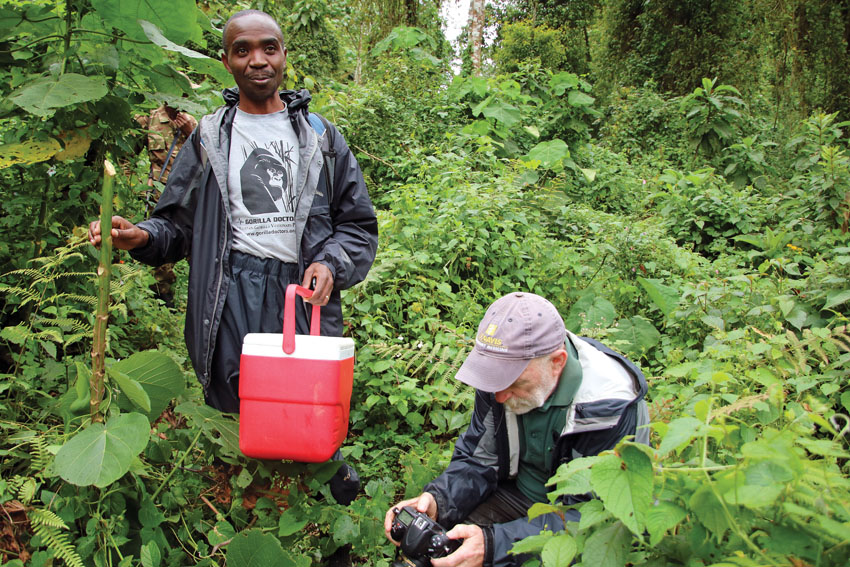
Gorilla Doctors Mike Cranfield and Fred Nizeyimana, carrying an ice chest to collect stool samples, on a Habituation Experience.
The two Gorilla Doctors with me, Africa director Mike Cranfield and Uganda field vet Fred Nizeyimana, are familiar with agitated 450-pound canine-toothed beasts. When doing hands-on interventions, the doctors shoot an ailing patient with a flying dart to inject a sleep-inducing anesthesia, then go to work while trackers keep defensive silverbacks at bay.
I know both “Dr. Mike” and “Dr. Fred” from my 2016 trip. The grown cheeky Baby Fred I adored had been named after Dr. Fred because years earlier the vet saved the theninfant’s life twice — once when a poacher’s wire snare sliced into the baby’s thigh and flung him upside down from a tree and another time when a poacher’s snare chokingly snapped around his neck. Sadly, three months after my 2016 visit, Baby Fred was fatally gored in the chest during a freakish confrontation with wild buffaloes. Dr. Fred had to perform the autopsy of his namesake on the forest ground, and even now, over a year later, he is emotional when recalling the pain on Baby Fred’s face as he lay dead.
Survival of the species also involves reducing “humangorilla conflict.” My base for this May outing is Nkuringo, a poverty-stricken rural enclave on the rim of Bwindi’s Impenetrable Forest. In the late 1990s, after being habituated, the Nkuringo gorilla family lost their fear of humans and began trudging down to raid potatoes, bananas and other crops that local humans needed to feed themselves. Villagers talked of poisoning the apes. Then in 2000, there was a horrible outbreak of scabies among gorillas, believed to have been contracted from villagers. (Human disease is a major threat to apes.) Ultimately, a buffer zone of tea groves was planted that repelled the gorillas — they don’t like the taste — and brings income to villagers. The upscale Clouds Mountain Gorilla Lodge was later built to generate more gorilla tourism dollars for locals — it’s operated by the private Wildplaces Africa company but owned by the Nkuringo community and employs all villagers, such as Monday, my kindly “butler,” born on a Monday and the eldest of nine children. By overnighting here, you’re helping to fund schools, the purchase of dairy heifers, handicraft training and other neighborhood programs, including those benefiting the outcast Batwa pygmies.
The Batwas are the short-statured indigenous people who peacefully lived a hunter-gatherer existence in the jungle for eons until being evicted in 1991, when Bwindi Impenetrable National Park was created to protect the gorillas. In Nkuringo, impoverished Batwas, clad in bark cloth and colorful African fabrics, take paying visitors on the short Buniga Forest Trail to theatrically demonstrate their ancient culture, including how they use medicinal plants, ceremoniously dance and once slept in grass huts. At the end of the presentation, they sell handcarved wood gorillas and handwoven baskets because souvenirs for ape-trekking tourists now help them get by.
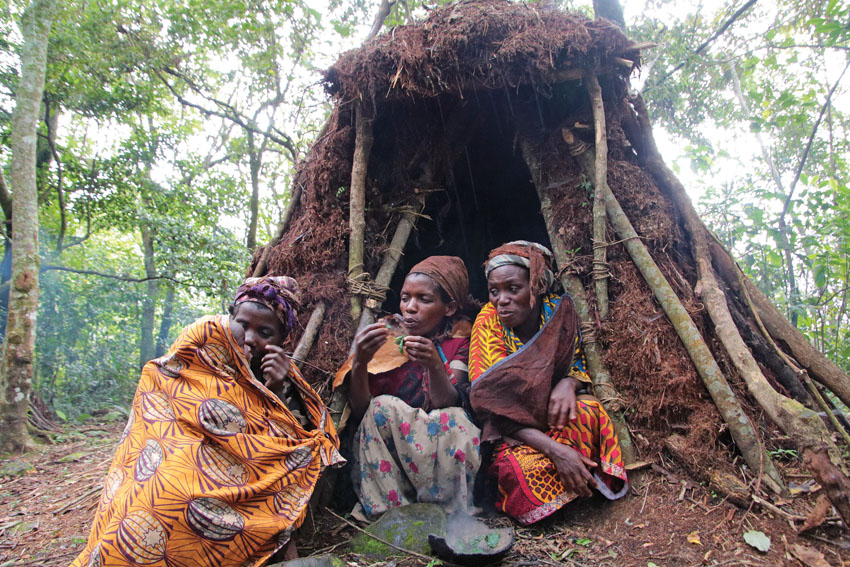
The Batwa “pygmies” show tourists how they once lived in the forest amid gorillas.
I ask their animated leader, Irene Muhawe, what it was like coexisting in Bwindi with wild apes. She exuberantly mimes running away while looking over her shoulder.
“The hands of the gorilla resemble a person’s,” she says through a translator. “The breasts are the same as a woman. They are our cousins.”
As for our shaggy kin, after the hike up, the four-hour Habituation Experience officially begins at the spot trackers saw the family the day before (gorillas travel daily to find food), so after locating them I have nearly three riveting hours among apes. Some gorillas run off when they hear us approach; others, including Rushenya, keep taking their siestas, affectionately piled atop and touching each other in a big black clump. Funnily, there is a lot of farting.
Dr. Fred focuses on the mother cradling the delicate onemonth- old. “Sometimes they will carry around their dead baby for a while,” he says. The infant squirms and Dr. Fred smiles widely and gives a thumbs-up.
Sixteen months earlier, another baby in this Bikingi group had a sagging distended belly that hampered its ability to move. After a feces specimen from its nest revealed live roundworms, Dr. Fred darted the sickly infant with a deworming medication, saving him.
Rushenya eventually arises and knuckle-walks farther into the forest, dutifully trailed by his children and mates. We tag behind but the vegetation is so tall and thick, all I unnervingly see and hear are branches cracking around me; we’re in their inner sanctum. As we tread on, impish youngsters magically appear, swinging from boughs and climbing trees. A mother with a fuzzy baby on her back scuttles into the lush foliage. Elsewhere, in heavy undergrowth, I glimpse another female sweetly hugging her teeny offspring. Twice during our search, we come across lone Rushenya, contently chomping on morning glory vines and picking his nails with razor-sharp teeth.
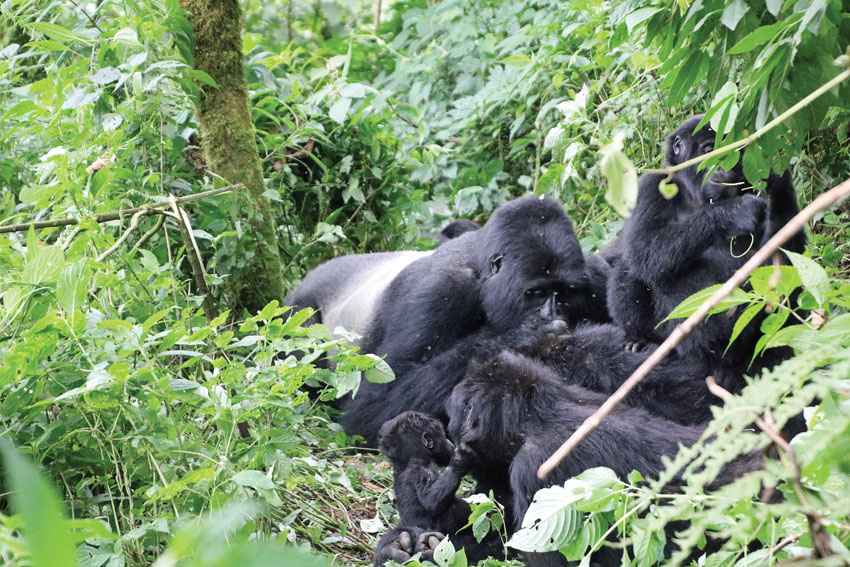
Rushenya with members of his gorilla troop.
The final time we meet up, the amber-eyed patriarch is stoically sitting by himself. Then, out of the blue, he screams hellishly frightening high-pitched “barks” while aggressively charging at us down a slight incline. This is when I instinctively take those two forbidden steps — or three — to bolt. Dr. Fred stops me. Rushenya also stops, within 10 feet. It’s explained, as my heart explodes, that Rushenya thought we were getting too close to mothers and infants. There are eight females and 12 babies in his family, although none are in sight right now. (Gorillas are considered “babies” until age 3, when they are weaned.) With that dramatic farewell, our viewing time is up.
On our trek back, Dr. Mike is happy about the thriving troop. “They all looked really healthy and anytime you see that, it’s great,” he says with a grin.
Exactly one week later, Rushenya is found severely injured with bloodied infected wounds over his body, his hands swollen with gaping gashes, his left forelimb dragging as he ambles, and in obvious pain. The 27-year-old protector had been attacked by a wild unhabituated silverback who was likely bent on taking over Rushenya’s family, particularly the females. This is another peril of the jungle. A colleague Gorilla Doctor is summoned and darts Rushenya with antibiotics, which combat infection and often spur recovery in these cases. But that very evening, Rushenya is attacked again.
Already weakened and vulnerable, Rushenya six days later is once more viciously attacked, this time by a semihabituated silverback, Mucunguzi, who had left his own troop and has been living a solitary existence. Rushenya again fights to keep his family, but suffers more serious injuries. Dr. Fred hikes into the forest on two different dates to dart the battered gorilla with antibiotics and a pain-relieving anti-inflammatory. During another follow-up checkup, his patient is moving slowly, feeding slightly and appears to be improving. But a few days later, Rushenya is found dead in his night nest. Dr. Fred’s postmortem shows the silverback had internal hemorrhaging and traumatic head wounds he could not recover from.
When I hear the devastating news, I immediately think about the 12 babies. Silverbacks who take over families will murder infants to bring breastfeeding females back into mating cycles. So far, the babies and mothers remain unharmed with Rushenya’s killer.
The loss of another mountain gorilla brings heartbreak to every human involved. But conservation efforts to save Fossey’s beloved apes push on. The Uganda Wildlife Authority is continuing the Habituation Experience with the Bikingi family, now led by Mucunguzi.
If You Go
ESSENTIALS Travel packages, which include either the required Habituation Experience permit ($1,500 per person) or gorilla trek permit ($600), plus transportation and accommodations, are available from outfitter Uganda Safari Company (safariuganda.com). You can also book a permit through the Uganda Wildlife Authority (ugandawildlife.org) or various tour operators.
STAYING THERE At nearly 7,000 feet, luxe Clouds Mountain Gorilla Lodge is Uganda’s highest lodge, with seven spacious stone cottages and a knockout view of the Virunga volcanoes. And you’re giving back to the community (wildplacesafrica.com).
GETTING THERE Part of the adventure. From Los Angeles, I flew Ethiopian Airlines (ethiopianairlines.com) to Ireland, then to Ethiopia and finally on to Entebbe, Uganda. After that, a 75-minute bush plane flight delivered me to a dirt airstrip, where a driver fetched me for an intriguing two-hour bumpy “African massage” ascent up a winding road past terraced verdant farms to Clouds. Along the way, dozens of barefoot Ugandan children yelled “Hello,” waved and excitedly called out, “Muzungu!” which means “white person” in the local dialect.
GORILLA DOCTORS Their work dates back to 1986. Shortly before her unsolved machete murder in Rwanda in 1985, Fossey was so alarmed there were only 250 mountain gorillas left worldwide that she asked for a veterinarian to come to Africa. Called the Mountain Gorilla Veterinary Project, it teamed up with the Karen C. Drayer Wildlife Health Center at UC Davis in 2009 to officially form Gorilla Doctors (gorilladoctors.org).

